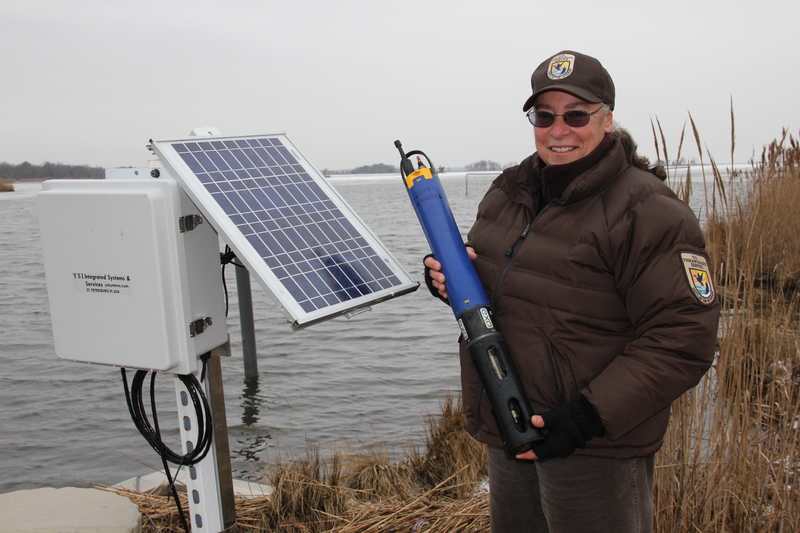Colossal refuge project teeing up, but ducks have left

Twenty years ago, it wasn’t unusual to find 40 to 60 groups of hunters waiting at the entrance to Prime Hook National Wildlife Refuge at 3:30 on many dark December and January mornings.
Speaking in hushed tones appropriate for that time of day, they kept their fingers crossed, hoping their number would be drawn for one of about 25 duck blinds, anticipating the excitement of tolling ducks and geese, calming water dogs smelling the hunt.
Now those days are gone. Only a handful of hunters show up on the days when drawings are held. “Hunters used to harvest 3,000 to 4,000 ducks and geese over the three splits of the waterfowl season,” said Annabella Larsen, a biologist at Prime Hook. “Now we’re down to about 1,000. And the composition has changed. Hunters used to bag primarily puddle ducks - pintails, mallards, blacks, gadwalls and wigeon. Now it’s mainly diving ducks: ruddy ducks, mergansers and more in that category.”
That change in composition of the ducks using Prime Hook points directly at what’s happened. The refuge used to be lots of big puddles with fresh and brackish water and food-producing vegetation. Those are all conditions preferred by puddle ducks. Then breaches in the thin barrier island north of the Primehook Beach community allowed Delaware Bay to flood the refuge with salt water. The salt in the water spelled the end of the food-producing vegetation. The deeper water resulting from the flooding made it impossible for salt marsh plants to take hold.
Now all of those puddles have been replaced by open water. Four thousand acres of open water, to be precise.
Gone too are the duck blinds that were part of the Prime Hook culture. Thank Hurricane Sandy and a change in the refuge management plan for that. “Our new management plan calls for no more built duck blinds,” said Larsen. “We were just going to let them go away by attrition. But Sandy expedited that. After the storm we found some of them floating down the Broadkill River, others washed out into the Atlantic.”
Great change underway
Larsen said the new plan means hunters have to carry in their own portable blinds and use refuge-supplied coordinates for where they can set up. “The guys that do that still do pretty well, getting their limits of what puddle ducks there are. But there aren’t many of them, and because all that water is tidal now and many of the former channels are gone, they might find themselves high and dry on a mud flat if they aren’t careful. We’re just going through huge change here. Colossal.
“It used to be we were the pintail capital of the East Coast in the winter,” said Larsen. “We would have 25,000 to 30,000 pintails. Now those numbers are way down. With climate change and sea level rise, we just can’t fight it anymore. Now what’s happening is mainly benefiting wading birds. Last August we had 5,000 to 10,000 of them in here. And that’s huge. I don’t think we’ll ever see the numbers of ducks that we used to have here.”
Over the next couple of years, starting this summer, millions of federal dollars will be spent in an attempt to convert those 4,000 acres of open water back into productive salt and brackish marsh. Larsen said this may be the largest restoration project underway east of the Rocky Mountains. The first phase of the project will be to restore about 30 miles of meandering channels from the north end of the refuge - connecting to the Slaughter Beach Canal - to the southern end of the refuge where it drains through Petersfield Ditch into the Broadkill River. “When the breaches are filled and we start getting proper tidal flow, and drainage, from Slaughter Beach Canal down through the refuge and to the Broadkill, that should allow spartina patens and spartina alterniflora to begin getting re-established for a proper marsh,” said Larsen.
To allow the new tidal flow to function properly, Larsen said DelDOT plans to build a new bridge on the Primehook Beach Road to carry traffic over the newly established channel. “That will have a crabbing platform and a place to watch birds. It will also eventually have a boardwalk to add further to its recreational benefit.”
These projects are in the permitting phase now. “A hairy mess,” said Larsen. “But we expect them to be approved in two to three months and be ready to start this big project in the summer, and fill the breaches starting next fall.”

















































